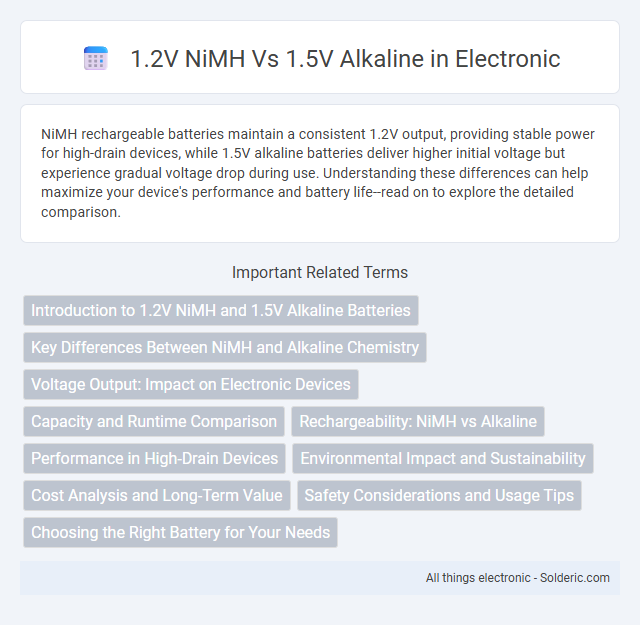NiMH rechargeable batteries maintain a consistent 1.2V output, providing stable power for high-drain devices, while 1.5V alkaline batteries deliver higher initial voltage but experience gradual voltage drop during use. Understanding these differences can help maximize your device's performance and battery life--read on to explore the detailed comparison.
Comparison Table
| Feature | 1.2V NiMH Battery | 1.5V Alkaline Battery |
|---|---|---|
| Nominal Voltage | 1.2 Volts | 1.5 Volts |
| Capacity | 600-2500 mAh | 1500-3000 mAh |
| Rechargeable | Yes | No |
| Discharge Behavior | Stable voltage during use | Voltage drops steadily |
| Self-Discharge Rate | High (10-20% per month) | Low (2-3% per year) |
| Typical Uses | High-drain devices, frequent use | Low to medium-drain, infrequent use |
| Environmental Impact | Reusable, less waste | Single-use, more waste |
| Cost per Use | Lower over time | Higher over time |
Introduction to 1.2V NiMH and 1.5V Alkaline Batteries
1.2V NiMH batteries are rechargeable cells known for their high capacity and stable voltage output, making them ideal for devices with moderate to high power consumption. In contrast, 1.5V alkaline batteries are disposable, offering a higher initial voltage and longer shelf life, suitable for low-drain electronics like remote controls and clocks. Choosing between the two depends on your device's power needs and whether rechargeability or longer storage time is a priority.
Key Differences Between NiMH and Alkaline Chemistry
NiMH batteries deliver a nominal voltage of 1.2V due to their metal hydride chemistry, while alkaline batteries provide about 1.5V from their zinc-manganese dioxide cells, impacting device compatibility and performance. NiMH batteries offer a lower internal resistance and superior rechargeability, making them ideal for high-drain devices and repeated use, whereas alkaline batteries have a longer shelf life and better performance in low-drain devices due to their stable voltage output. Understanding these chemistry-based differences helps you select the optimal battery type based on voltage requirements and application needs.
Voltage Output: Impact on Electronic Devices
1.2V NiMH batteries deliver a stable voltage output throughout their discharge cycle, which can enhance the performance and longevity of electronic devices sensitive to voltage fluctuations. In contrast, 1.5V alkaline batteries start with a higher voltage that gradually decreases, potentially causing inconsistent device operation as power drops. Choosing NiMH batteries can ensure consistent voltage, benefiting your devices that require steady power for optimal functionality.
Capacity and Runtime Comparison
1.2V NiMH batteries typically offer a higher capacity, measured in mAh, compared to 1.5V alkaline batteries of the same size, resulting in longer runtime for high-drain devices. NiMH cells maintain a more stable voltage output throughout their discharge cycle, while alkalines experience a gradual voltage drop, affecting performance in sensitive electronics. Your choice between NiMH and alkaline should consider the device's power demands and whether extended runtime or consistent voltage is more critical.
Rechargeability: NiMH vs Alkaline
1.2V NiMH batteries offer superior rechargeability, typically supporting up to 500-1000 charge cycles, making them cost-effective and environmentally friendly for frequent use. In contrast, 1.5V Alkaline batteries are predominantly single-use, designed for disposable applications with limited or no effective recharge capability due to their chemical composition. NiMH rechargeability combined with stable voltage output ensures consistent performance in high-drain devices compared to the diminishing voltage of alkaline cells over time.
Performance in High-Drain Devices
1.2V NiMH batteries maintain a more stable voltage under high-drain conditions, delivering consistent power output in devices such as digital cameras and flashlights. 1.5V Alkaline batteries start with higher voltage but experience a rapid voltage drop during heavy use, leading to shorter effective runtime. High-drain electronic devices benefit from NiMH rechargeables due to their lower internal resistance and ability to sustain current flow efficiently.
Environmental Impact and Sustainability
NiMH batteries, typically rated at 1.2V, offer greater environmental benefits compared to 1.5V Alkaline batteries due to their rechargeable nature, significantly reducing waste and resource consumption over multiple charge cycles. NiMH cells use fewer harmful heavy metals and can be recycled more efficiently, minimizing toxic landfill contributions and environmental pollution. In contrast, single-use alkaline batteries generate more waste and require frequent disposal, contributing to higher environmental impact and lower sustainability.
Cost Analysis and Long-Term Value
1.2V NiMH rechargeable batteries offer lower cost per use compared to 1.5V alkaline batteries due to their ability to be recharged hundreds of times, reducing the need for frequent replacements. Although alkalines have a higher initial purchase price per unit, their single-use nature leads to greater cumulative expenses over time, especially in high-drain devices. Your long-term value is maximized with NiMH cells, as their consistent voltage output and rechargeability provide cost efficiency and environmental benefits.
Safety Considerations and Usage Tips
1.2V NiMH batteries offer enhanced safety due to their lower voltage and reduced risk of leakage or rupture compared to 1.5V alkaline batteries, which can sometimes leak corrosive electrolyte under stress. For safe operation, NiMH batteries should be charged with compatible chargers to prevent overcharging and overheating, while alkaline batteries are single-use and require careful disposal to avoid environmental harm. When using devices, NiMH batteries perform best in high-drain applications and maintain a more stable voltage output, whereas alkaline batteries may be preferable for low-drain devices where longevity and initial voltage matter most.
Choosing the Right Battery for Your Needs
NiMH batteries provide a stable voltage of 1.2V and excel in high-drain devices due to their rechargeable nature and consistent power output, while 1.5V alkaline batteries offer higher initial voltage and longer shelf life, making them ideal for low-drain or infrequently used devices. Selecting the right battery depends on device power requirements, usage frequency, and cost-effectiveness; NiMH batteries reduce waste and long-term expenses, whereas alkaline batteries are convenient for occasional use. Understanding device compatibility with voltage and discharge rates ensures optimal performance and longevity.
1.2V NiMH vs 1.5V Alkaline Infographic

 solderic.com
solderic.com